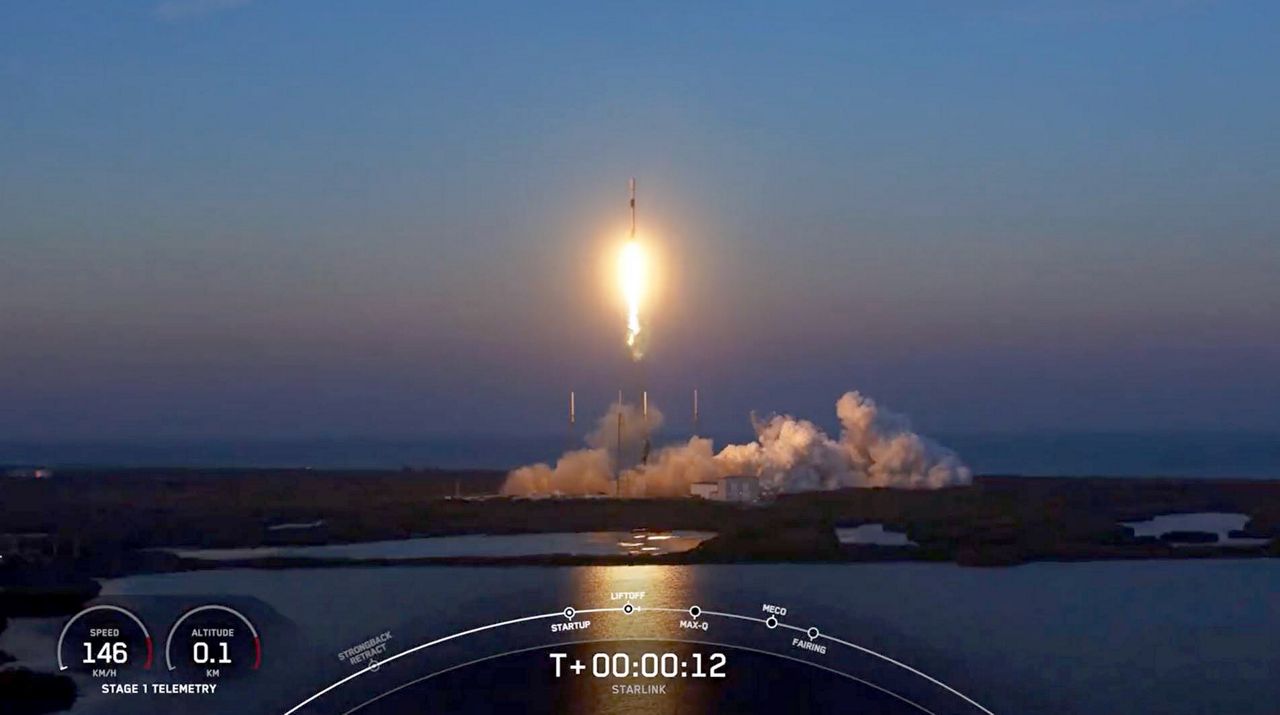CAPE CANAVERAL SPACE FORCE STATION — Despite weather pushing back the launch window, SpaceX was able to send up the next generation of Starlink satellites Monday evening.
What You Need To Know
- A new generation of Starlink satellites was sent up
- 🔻Scroll down to watch the launch🔻
Liftoff! pic.twitter.com/OSWplR75Dg
— SpaceX (@SpaceX) February 27, 2023
At the new launch time of 6:13 p.m. EST, the Falcon 9 rocket sent up 21 second-generation Starlink satellites to low-Earth orbit from Space Launch Complex 40 at Cape Canaveral Space Force Station.
The 45th Weather Squadron is giving a 95% chance of good liftoff, stated SpaceX. The only slight concern was the cumulus cloud rule, stated the 45th Weather Squadron.
The first-stage rocket, B1076, has only been on two missions before:
After the stage separation, the first stage landed on the droneship A Shortfall of Gravitas in the Atlantic Ocean.
Falcon 9’s first stage has landed on the A Shortfall of Gravitas droneship pic.twitter.com/CFdhCVuOby
— SpaceX (@SpaceX) February 27, 2023
Trying to launch
The first launch window for Monday had been at 1:38 p.m. EST, but it was pushed back due to weather concerns.
Due to a space weather concern, now targeting no earlier than 6:13 p.m. ET for today’s launch of 21 second-generation Starlink satellites from Florida
— SpaceX (@SpaceX) February 27, 2023
This is not the first launch adjustment for this mission. The launch was originally set for Thursday, Feb. 23, at 1:37 p.m. EST.
This comes at a trying time for the California-based space company as it aimed to launch its joint Crew-6 mission with NASA during the early morning hours on Monday. But the Crew-6 was scrubbed due to an issue and it will now launch on Thursday morning.
So currently, the only Florida launch for Monday by SpaceX was the Starlink Group 6-1 mission.
In addition, SpaceX was looking at another launch on Monday, but not in the Sunshine State. At 2:31 p.m. EST, SpaceX was planning to launch 51 Starlink satellites from Vandenberg Space Force Base in California, stated the company. However, weather conditions canceled those plans.
Standing down from today’s launch of 51 Starlink satellites from California due to unfavorable weather conditions. There is another opportunity tomorrow and the team is keeping an eye on weather
— SpaceX (@SpaceX) February 27, 2023
About the mission
We call them “V2 Mini”. They represent a step forward in Starlink capability pic.twitter.com/EFVpLFcz7n
— SpaceX (@SpaceX) February 26, 2023
According to the company that is operated by SpaceX, the Starlink satellites provide internet access to most of the round world.
The Starlink satellites going up is a new batch: Second generation.
“With the recent authorization of our second-generation network, or "Gen 2," SpaceX will provide even faster speeds to more users. This new authorization enables SpaceX to launch additional, much-improved spacecraft with significantly more throughput per satellite than the first-generation systems. For the end consumer, this means more bandwidth and increased reliability. As a result, millions of more Americans will have access to high-speed internet no matter where they live,” stated SpaceX.
Before Monday afternoon’s launch, astronomer Jonathan McDowell of the Harvard-Smithsonian Center for Astrophysics recorded the following information on the current Starlink satellites: 3,683 are in orbit, with 3,639 in working order and 3,194 actively operating.








